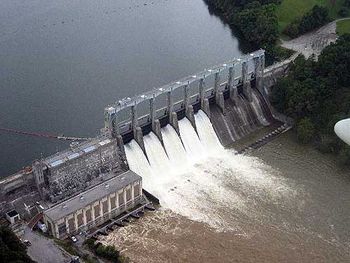Dispatchable source of electricity

A dispatchable source of electricity refers to an electrical power system, such as a power plant, that can be turned on or off; in other words they can adjust their power output supplied to the electrical grid on demand.[2] Most conventional power sources such as coal or nuclear power plants are dispatchable in order to meet the always changing electricity demands of the population. In contrast, many renewable energy sources are intermittent and non-dispatchable, such as wind power or solar power which can only generate electricity while their primary energy flow is input on them.
Dispatch times
Dispatchable sources must be able to ramp up or shut down relatively quickly in time intervals within a few seconds even up to a couple of hours, depending on the need for electricity. Different types of power plants have different dispatch times:[3]
Fast (seconds)
- Capacitors are able to dispatch within milliseconds if they need to, due to the energy stored in them already being electrical, whereas in other types of power storage such as chemical batteries the power must be converted into electrical energy.
- Hydroelectric facilities are also able to dispatch extremely quickly; for instance the Dinorwig hydro power station can reach its maximum generation in less than 16 seconds.[4]
Medium (minutes)
- Natural gas turbines are a very common dispatchable source, and they can generally be ramped up in minutes.
- Solar thermal power plants can utilize systems of efficient thermal energy storage. It is possible to design these systems to be dispatchable on roughly equivalent timeframes to natural gas turbines.
Slow (hours)
While these systems are typically regarded as only providing baseload power, they often have some flexibility.
Many coal and biomass plants can be fired up from cold within a few hours. Although nuclear power plants may take a while to get going, they must be able to shut down in seconds to ensure safety in the case of a meltdown.
Importance
Dispatchable sources of electricity are of high importance in modern society. The main reasons for their use are:[3]
- Load matching- This refers to the changing need for power throughout the day since generally far less electricity is needed at night than during the day. Load matching plants can vary their output slowly over hours to meet the general trend in this.
- Peak matching- Peak matching is done by power plants to meet the highest electricity use during the day. Demand typically peaks for power grids at a relatively predictable time, depending on culture, weather and geographic location.
- Cover lead-in times- A lead-in time is the amount of time that a power plant takes to get to its desired output, and as seen above many of the common power plants take some time to achieve this. Therefore it is important for power generation that can be deployed quickly to ensure the supply meets the electricity demand during these times.
- Cover intermittent sources- Intermittent electricity sources do not produce consistent electricity, therefore their power output cannot be controlled. Although they provide valuable electricity, they do not provide guaranteed electricity, therefore dispatchable sources are required when they are not meeting their production demands.
References
- ↑ Baird, Hydropower Reservoir Study [Online], Available: http://www.baird.com/assets/images-project/claytor5.jpg
- ↑ Johnson Cornell University, Johnson’s Energy Club Competes in Renewable Energy Case Competition [Online], Available: http://www.johnson.cornell.edu/Center-for-Sustainable-Global-Enterprise/News-Events/CSGE-Student-Article-Detail/ArticleId/34158
- ↑ 3.0 3.1 Vision of Earth, How can renewables deliver dispatchable power on demand? [Online], Available: http://www.visionofearth.org/industry/renewable-energy/renewable-energy-review/how-can-renewables-deliver-dispatchable-power-on-demand/
- ↑ First Hydro Company, Dinorwig Power Station [Online], Available: http://www.fhc.co.uk/dinorwig.htm

